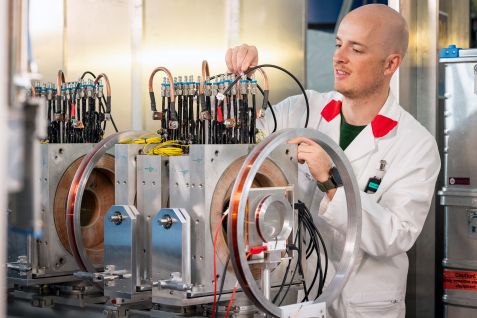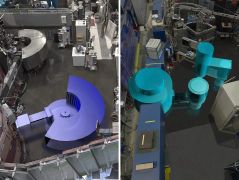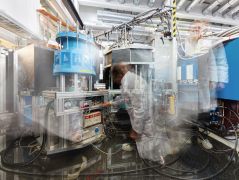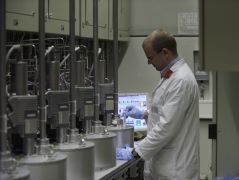MLZ is a cooperation between:
 > Technische Universität München
> Technische Universität München > Helmholtz-Zentrum Hereon
> Helmholtz-Zentrum Hereon
 > Forschungszentrum Jülich
> Forschungszentrum Jülich
MLZ is a member of:
 > LENS
> LENS > ERF-AISBL
> ERF-AISBL
MLZ on social media:

MLZ (eng)
Lichtenbergstr.1
85748 Garching
30.01.2024
Clarifying the structure of the skin barrier
Promises made by moisturizers range from helping against dry skin to rejuvenating effects. The buzzword: ceramides. Quite a lot of responsibility for this group of molecules. But that’s not all: they also form the natural barrier in the outermost layer of the skin. However, the structures in which the lipids arrange themselves in the skin must be better studied in order to understand how they function. Neutron scattering is a particularly suitable method for that.
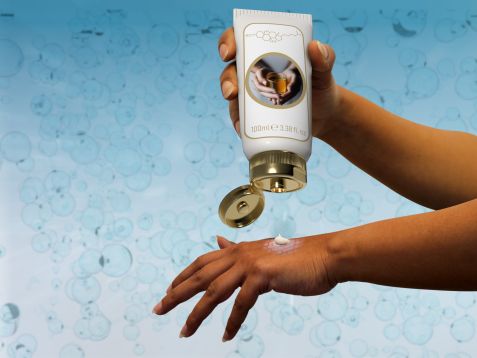
Moisturizers provide ceramides when the skin itself can’t supply enough of them. Ceramides form a very thin film between the cornified flattened cells of the superficial skin layer. © Reiner Müller, FRM II / TUM
Ceramides belong to the lipids (from the Greek: “fat”). These are molecules consisting of long chains of carbon and hydrogen atoms. Just like oil and fat, these chains are hydrophobic, meaning they do not dissolve in water. In the case of ceramides, there is also a hydrophilic (having affinity to water) part connecting the two hydrophobic chains. The interaction of the hydrophobic and hydrophilic parts allows several ceramides to self-assemble into larger structures.
Thin ceramide film in the skin retains moisture
For example, ceramides, together with other lipids, form a very thin film between the cornified flattened cells of the superficial skin layer. Here, the lipids prevent the body’s moisture from evaporating while preventing the substances to permeate from the environment through the skin. Moisturizers provide ceramides when the skin itself can’t supply enough of them. The structure in which the ceramides are arranged in the skin is crucial to how this works – a question that has not yet been fully answered. Yet, it is important, among other things, for the optimization of moisturizers. After all, the structure dictates how water molecules can fit inside the film and, therefore, what its permeability is.
Neutrons see ceramides particularly well
A group of scientists from Charles University in Prague, the University of Chemistry and Technology Prague, and the Comenius University Bratislava devoted themselves to contributing to answering precisely this question. Scattering experiments with X-rays and neutrons are the methods of choice here. From the scattering pattern, the distances between two layers of ceramides as well as their arrangement within a layer can be determined. Neutrons have a decisive advantage over X-rays. They are much more sensitive to light atoms, which is particularly important for ceramides, which consist mainly of hydrogen and carbon. In addition, with neutrons one can easily distinguish between hydrogen and deuterium, the heavy hydrogen isotope. By selectively exchanging hydrogen with deuterium in the sample, it is possible to gain additional information about the structure of the ceramides.
Maiden voyage for MIRA in biofilm measurements
The scientists measured their samples with the MIRA instrument of the Technical University of Munich at the MLZ. “It was the first time for us to perform such a measurement with our instrument,” says Dr. Robert Georgii, instrument scientist at MIRA. “One reason it worked so well is the very low background in our measurements,” he continues. “That’s because we’re far enough away from the reactor and therefore no background neutrons stray into our detector. In addition, the triaxial spectrometer setup ensures that we only detect the neutrons that actually contribute to the measurement.” With this expertise gained, more such experiments will follow in the future. However, these will be carried out at MIRA’s successor LaDiff, which is currently being set up on MIRA’s former location.
Structures depend on the temperature
The guest scientists are also satisfied with the results. Using X-ray measurements, they were able to show that the ceramides can arrange themselves in two different structures, the so-called “short lamellar phase” (SLP) and the “medium lamellar phase” (MLP). Which of the two is adopted depends on environmental conditions, in particular on the temperature and humidity.
A plausible model for the arrangement
“This was the first time that the neutron diffraction patterns were obtained and reported on the MLP structure. Thanks to the neutrons we gained additional information about the water distribution across the MLP repeat unit,” says Petra Pullmannová of Charles University in Prague and lead author of the paper. The repeat unit in a long molecular chain is the smallest repeating building block. ”The measurement was technically challenging due to the relatively long repeating building block of this structure. All in all, we were able to propose a plausible model for the arrangement of the molecules and thus better understand how ceramides work.”
Original publication:
Petra Pullmannová, Barbora A. Čuříková-Kindlová, Veronika Ondrejčeková, Andrej Kováčik, Kristýna Dvořáková, Lucia Dulanská, Robert Georgii, Adam Majcher, Jaroslav Maixner, Norbert Kučerka, Jarmila Zbytovská, and Kateřina Vávrová:
Polymorphism, Nanostructures, and Barrier Properties of Ceramide-Based Lipid Films
ACS Omega 2023 8 (1), 422-435
https://doi.org/10.1021/acsomega.2c04924
More Information:
Skin Barrier Research Group:
https://portal.faf.cuni.cz/Groups/Skin-barrier-research-group/
University of Chemistry and Technology Prague – Faculty of Chemical Technology:
https://www.vscht.cz/?jazyk=en
Comenius University Bratislava – Faculty of Pharmacy:
https://www.fpharm.uniba.sk/en/
Related News
-
26.11.2020
The frustrated “third wheel” in a magnet
MLZ is a cooperation between:
 > Technische Universität München
> Technische Universität München > Helmholtz-Zentrum Hereon
> Helmholtz-Zentrum Hereon
 > Forschungszentrum Jülich
> Forschungszentrum Jülich
MLZ is a member of:
 > LENS
> LENS > ERF-AISBL
> ERF-AISBL
MLZ on social media:




